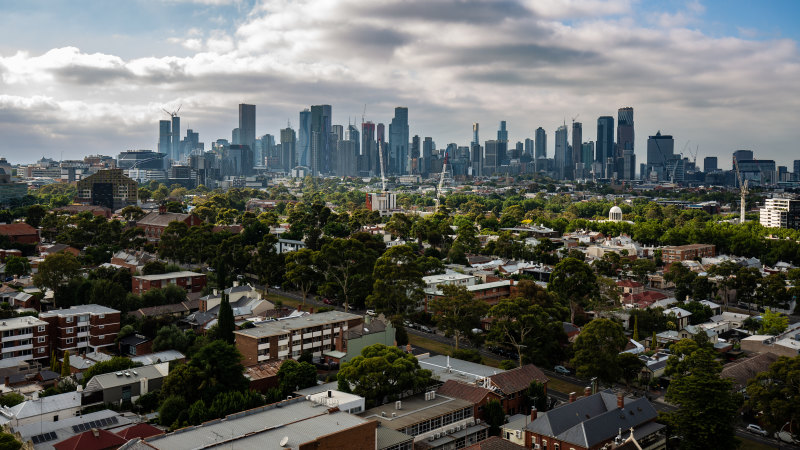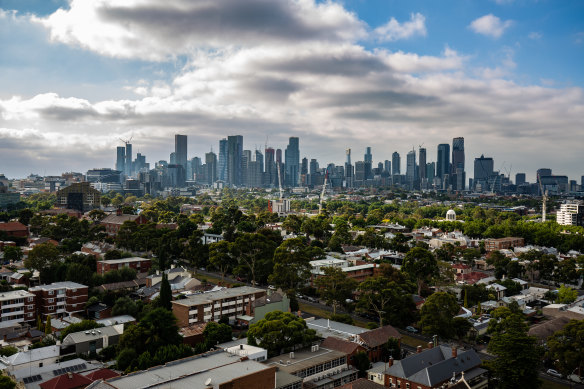Save articles for later
Add articles to your saved list and come back to them any time.
If you believe the forecasts, Melbourne will be a vastly changed place in the not-too-distant future.
For a start, the city is expected to grow by about 1 million people over the next 10 years.
The plan is to squeeze an extra million homes into Melbourne’s established suburbs by the middle of the century.Credit: Scott McNaughton
By 2033, according to the boffins at federal Treasury’s Centre for Population, it will overtake Sydney as Australia’s largest city, with 6.1 million inhabitants. About three-quarters of the new arrivals will be overseas migrants.
Melbourne will also be far more crowded. The plan is to squeeze an extra million homes into established suburbs by the middle of the century, as part of a push to slow the geographical expansion of the city.
As Premier Daniel Andrews put it last week: “It doesn’t make sense to keep on building suburb after suburb.
“We need to create more housing with the best design standards where people want to live.”
Considering there are currently about 2.1 million dwellings in Greater Melbourne, hitting the target will require roughly one new dwelling for every two existing homes within the city’s boundaries.
Having taken about 188 years to get to our current situation, accommodating 50 per cent more houses within existing boundaries in the next 20 years represents a major policy challenge.
The 19th century French philosopher and sociologist Auguste Comte is often credited with the phrase “demography is destiny”. The fortunes of cities and nations do indeed rise and fall on great trends of births and deaths, and movements of people.
Planning laws don’t normally deal in such grandiose notions. But the Andrews government is talking a big game, promising one of the most significant planning and housing affordability shake-ups in the state’s history.
The big question is whether the government’s reforms can be delivered without undermining Melbourne’s coveted liveability. The stakes are high: the alternative is a sprawling, overburdened megacity that is paradoxically a place of isolation for many citizens forced to the fringes.
Infrastructure Victoria chief executive Jonathan Spear argues that simply lowering migration to tackle concerns about the supply of housing would be counter-productive.
“Debates about whether or not we should have population growth hold us back from the real conversation we should be having, which is how can we be smart about delivering the land use and infrastructure planning policies which will enable us to absorb and make the best of that population growth,” he told The Age.
The government will attempt to tackle multiple objectives in a single policy statement, due to be released in September: boosting urban infill, tackling housing affordability, increasing the supply of houses, helping renters and improving planning processes.
According to the premier, “everything is on the table”.
In the past, Melbourne hasn’t been very good at delivering high-quality, medium-density housing options in the middle suburbs. For a household earning $88,021 a year, buying a house anywhere near the city, or even in Melbourne’s middle suburbs, is now out of the question, according to Infrastructure Victoria modelling.
The reality is that about one in five Melbourne households who currently live in greenfield areas would rather live in established parts of Melbourne.
Planning expert Marcus Spiller, from SGS Economics and Planning, said tackling future population growth is going to require a major reinvention of the planning system.
“In other jurisdictions, namely in Europe, the government plays a much more proactive role in consolidating land, getting it development-ready, organising the infrastructure, master-planning it, and then wholesaling it to the development sector to provide the housing,” Spiller said.
“If you just rely on the ad hoc, opportunistic approach, as we have done until now, I think it is very problematic.”
But Spiller argued Melbourne’s coveted liveability status has itself been a function of the densification that has taken place since the mid-1990s. “If you look at AC/DC’s It’s a Long Way to the Top [1976] clip filmed on the back of the flatbed truck travelling down Swanston Street, the place was a ghost town, and the CBD was bereft of activity.”
Encouraging higher density
As revealed by The Age earlier this year, a key plank of the government’s plan to tackle the state’s growing pains will be to strip local councils of decision-making powers for major developments, particularly those in key development zones close to public transport, such as along the government’s flagship Suburban Rail Loop.
The push was bolstered by the release of a report by Victoria’s Independent Broad-based Anti-corruption Commission into developer payments linked to Casey Council, which detailed how developer and consultant John Woodman dished out more than $1 million in alleged bribes to councillors and sought to influence politicians on both sides.
Among the recommendations flowing from the investigation – known as Operation Sandon – was a proposal for setting up independent panels as decision-makers for statutory planning matters statewide.
Andrews this week seized on the findings, suggesting that trusting local councillors with big planning decisions such as rezoning was risky, given the large sums of money involved.
“To have part-time councillors making decisions to turn, say, farmland into a new suburb where you are talking about vast amounts of money – there’s clearly a risk that things can go wrong,” he said.
There is an added argument that councils are to blame for a “not-in-my-backyard” approach, whereby development proposals are knocked back on behalf of the residents they represent.
Whether transferring decision-making from local government to state government for major planning decisions will help tackle the state’s housing challenges is debatable.
Professor Andrew Butt at RMIT’s Centre for Urban Research said he was concerned the state government would use the recommendations from Sandon as cover for its planning agenda.
“What came out of the [Sandon] report was that the planning experts were found by IBAC to have behaved quite appropriately – it was the lack of evidence-based decision-making [by the councillors] that was criticised,” he said.
Butt said the government had previously emphasised fast-tracking processes, and a narrative had been constructed that it was councils that slowed down the provision of homes.
Data published last month by The Age showed many municipalities criticised for their “NIMBY-ism” in fact approved the vast majority of applications that came before them.
Butt said he was also concerned that after the state government abandoned its proposed social-housing levy it could lead to “open slather” for development without the provision of much-needed social or affordable housing.
His concerns were echoed by the peak body for local councils, the Municipal Association of Victoria.
“With the report clearly stating that corruption risk cannot be resolved by transferring responsibility from elected councillors to a minister, it would be a travesty for the Andrews government to use the findings to centralise planning powers within the backrooms of Spring Street,” councillor and MAV president David Clarke said in response to the Sandon report.
Tackling housing affordability
A big part of the political equation for the Andrews government is tackling housing affordability. The combination of soaring prices, higher interest rates, rising building costs, sluggish wage growth, and other cost-of-living pressures has left a huge cohort of voters either completely shut out of the housing market, or facing the prospect of buying on Melbourne’s far-flung fringe.
As reported in The Age this week, one option being closely considered is to scrap Victoria’s $10,000 First Home Owner Grant provided to people purchasing a newly built home worth up to $750,000.
The evidence clearly suggests the grant scheme, which costs an average of about $157 million a year, has been a disaster in terms of tackling housing affordability, with the cash mostly flowing to sellers and developers through higher prices, rather than the first home buyers it is supposed to help.
The cash has also overwhelmingly flowed to growth areas where newly built homes were more likely to cost less than the $750,000 cap, which grates against the government’s urban infill objectives.
Infrastructure Victoria, in particular, has urged the state government to replace the scheme with better-targeted measures to boost home ownership in existing suburbs, such as beefed-up shared equity schemes.
Streamlining planning approvals
The problem is, axing the upfront cash payment would be politically tricky, requiring some delicate public relations to appease aspiring home buyers and well-organised developers.
These political risks are likely to be reduced by offering developers a significant carrot: a streamlined assessment process for big projects, and other major efforts to cut red tape around planning.
If you believe the government, such changes have the potential to cut up to six months off planning permit applications, delivering about $7 billion in benefits and creating tens of thousands of jobs over a decade.
What about renters?
With growing numbers of younger voters now shut out of Victoria’s runaway housing market, renters are seen as an increasingly important political bloc. According to census data compiled by The Age, about 22 per cent of households were renting in 2001. Today, that figure is almost 29 per cent, while the proportion of homes owned outright has dropped from about 43 per cent to 32 per cent.
As part of the housing overhaul, the government is mulling new laws under which landlords would be able to lift rent only once every two years, up from the current 12-month limit in most cases.
As revealed in The Age, Treasury officials have also been considering the consequences of combining that new time limit with a rental cap.
There are several possibilities, including the model used in the ACT, where rent increases are limited to 110 per cent of the rate of inflation. Although that has led to smaller-than-average rent increases, a concern is that linking increases to inflation could mean rents would rise more when tenants are most affected by cost-of-living pressures.
With Rachael Dexter
The Morning Edition newsletter is our guide to the day’s most important and interesting stories, analysis and insights. Sign up here.
Most Viewed in National
From our partners
Source: Read Full Article



